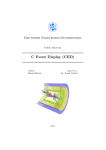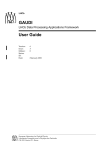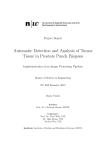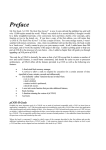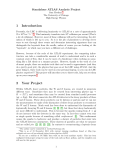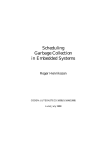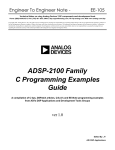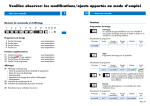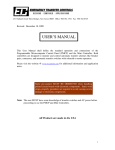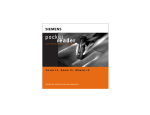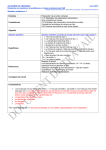Download LCIO - Users manual
Transcript
LCIO - Users manual
v02-04
F. Gaede, DESY IT
H. Vogt, DESY Zeuthen
February 6, 2014
Contents
1 INTRODUCTION
2
2 Installation
2.1 Getting LCIO . . . . . . . .
2.2 Requirements . . . . . . . .
2.3 Building LCIO . . . . . . .
2.4 Checking the Installation .
2.5 Building the documentation
.
.
.
.
.
.
.
.
.
.
.
.
.
.
.
.
.
.
.
.
.
.
.
.
.
.
.
.
.
.
.
.
.
.
.
.
.
.
.
.
.
.
.
.
.
.
.
.
.
.
.
.
.
.
.
.
.
.
.
.
.
.
.
.
.
.
.
.
.
.
.
.
.
.
.
.
.
.
.
.
.
.
.
.
.
.
.
.
.
.
.
.
.
.
.
.
.
.
.
.
.
.
.
.
.
.
.
.
.
.
.
.
.
.
.
.
.
.
.
.
.
.
.
.
.
.
.
.
.
.
.
.
.
.
.
.
.
.
.
.
.
.
.
.
.
.
.
.
.
.
.
.
.
.
.
.
.
.
.
.
.
.
.
.
.
2
2
2
2
3
4
3 Using LCIO
3.1 Java and C++ API . . .
3.2 Data model . . . . . . .
3.3 TrackerRawData . . . .
3.4 TrackerData . . . . . . .
3.5 TrackerPulse . . . . . .
3.6 Data format . . . . . .
3.7 How to read LCIO files
3.8 How to write LCIO files
3.9 The Fortran Interface .
.
.
.
.
.
.
.
.
.
.
.
.
.
.
.
.
.
.
.
.
.
.
.
.
.
.
.
.
.
.
.
.
.
.
.
.
.
.
.
.
.
.
.
.
.
.
.
.
.
.
.
.
.
.
.
.
.
.
.
.
.
.
.
.
.
.
.
.
.
.
.
.
.
.
.
.
.
.
.
.
.
.
.
.
.
.
.
.
.
.
.
.
.
.
.
.
.
.
.
.
.
.
.
.
.
.
.
.
.
.
.
.
.
.
.
.
.
.
.
.
.
.
.
.
.
.
.
.
.
.
.
.
.
.
.
.
.
.
.
.
.
.
.
.
.
.
.
.
.
.
.
.
.
.
.
.
.
.
.
.
.
.
.
.
.
.
.
.
.
.
.
.
.
.
.
.
.
.
.
.
.
.
.
.
.
.
.
.
.
.
.
.
.
.
.
.
.
.
.
.
.
.
.
.
.
.
.
.
.
.
.
.
.
.
.
.
.
.
.
.
.
.
.
.
.
.
.
.
.
.
.
.
.
.
.
.
.
.
.
.
.
.
.
.
.
.
.
.
.
.
.
.
.
.
.
.
.
.
.
.
.
.
.
.
.
.
.
.
.
.
.
.
.
.
.
.
.
.
.
.
.
.
.
.
.
.
.
.
.
.
.
.
.
.
.
.
.
.
.
.
.
.
.
.
.
.
4
5
6
9
9
10
12
12
15
17
4 Real world examples
4.1 lcioframe (C++, Root) . . .
4.2 aida (JAVA, AIDA) . . . .
4.3 lciohbook (Fortran, Hbook)
4.4 pythia (Fortran, Pythia) . .
.
.
.
.
.
.
.
.
.
.
.
.
.
.
.
.
.
.
.
.
.
.
.
.
.
.
.
.
.
.
.
.
.
.
.
.
.
.
.
.
.
.
.
.
.
.
.
.
.
.
.
.
.
.
.
.
.
.
.
.
.
.
.
.
.
.
.
.
.
.
.
.
.
.
.
.
.
.
.
.
.
.
.
.
.
.
.
.
.
.
.
.
.
.
.
.
.
.
.
.
.
.
.
.
.
.
.
.
.
.
.
.
.
.
.
.
.
.
.
.
.
.
.
.
.
.
.
.
.
.
.
.
22
22
22
22
22
A ChangeLog
A.1 Changes from v1.3 to v1.4 . . . . . . . . . . . . . . . . . . . . . . . . . . . . . . . . . .
A.2 Changes from v1.0 to v1.3 . . . . . . . . . . . . . . . . . . . . . . . . . . . . . . . . . .
23
23
23
B Summary of Fortran API Functions
25
.
.
.
.
.
.
.
.
.
1
1
INTRODUCTION
Note: Some of the latest developments in LCIO are not yet described in this manual.
However it is still a good starting point if you are new to LCIO as it explains the basic
concepts to quite some detail. For some of the newer developments and the current
versions please refer to the API documentation at http://lcio.desy.de and the discussions in
the LCIO forum at http://forum.linearcollider.org.
LCIO is a persistency framework that defines a data model for the linear collider physics community.
It is intended to be used in both simulation studies and analysis frameworks. Its light weight and
portability makes it also suitable for use in detector R&D applications.
It provides a C++ and a Java implementation with a common interface (API). A Fortran interface
to the C++ implementation is provided as well.
This manual is intended for application developers that want to incorporate LCIO in their programs.
This includes e.g. simulation developers as well as physicists that want to read LCIO files for their
analysis. It focuses on the practical aspects of using LCIO. A more general discussion can be found
in [1] and other documents listed on the LCIO homepage [2].
2
Installation
2.1
Getting LCIO
If LCIO is not yet installed at your site you can get a recent copy from the SVN repository as follows
bash:
svn co svn://svn.freehep.org/lcio/tags/v01-60 lcio/v01-60 # checkout release v01-60
svn co svn://svn.freehep.org/lcio/trunk lcio/trunk # checkout trunk
2.2
Requirements
In order to build LCIO you need to have a Java VM (version 1.4 or higher) installed on your platform.
This is true even if you only want to install the C++ version as the API-files are generated from an
abstract description for Java and C++ using the AID [4] tool. The build scripts used in LCIO also
require that gcc and gmake/make are installed.
The C++ version of LCIO is developed and tested under Linux (SL4 and SL5 32 and 64bit) and also
builds under Windows/Cygwin or MacOSX.
As the -ansi compiler flag is used it should be fairly easy to port it to other platforms with an ANSI
compliant C++ compiler.
2.3
Building LCIO
There are two build tools that can be used to build LCIO: maven and CMake [12].
CMake [12] has been introduced in version v01-11 to facilitate cross plattform support for the C++
version.
2.3.1
Building LCIO with CMake
If you want to use CMake for building LCIO you need at least CMake version 2.6.
If you want to build LCIO using CMake, make sure that the cmake command is in your path, e.g.
export PATH=Path_to_CMake/bin:$PATH
Then issue the following commands:
2
mkdir build
cd build
cmake ..
# <-- create an out-of-source directory for the build
# check build options ( change options with: cmake -DOPTION=ON|OFF .. )
# e.g. to also build the Java version, use: cmake -DINSTALL_JAR=ON ..
# optionally use: ccmake .. and configure interactively
make install
CMake options may also be specified in a separate file and read with the -C option. (please check the
CMake [12] documentation for more details)
#
#
#
#
ILCSoft.cmake is a configuration file generated for each ilcsoft reference installation.
It contains the list of paths from all tools within the installation.
in this example the BUILD_ROOTDICT option from LCIO is activated which requires the
path to the ROOT package. This path is read from the ILCSoft.cmake configuration file.
cmake -C /afs/desy.de/project/ilcsoft/sw/i386_gcc41_sl5/v01-11/ILCSoft.cmake \
-DBUILD_ROOTDICT=ON ..
2.3.2
Building LCIO with Maven
Download and install Maven (http://maven.apache.org/download.html) and then type
mvn clean install
Both ways of building LCIO will create the following libraries and executables:
./lib
lcio.jar
liblcio.so
libsio.so
<-- Java library (and executables)
<-- C++ lcio library
<-- C++ sio library
./bin
<-- C++ examples and tools
anajob
copyfix
dumpevent
readcalibration
recjob
simjob
lcio_event_counter
stdhepjob
./bin
anajob_F
simjob_F
recjob_F
2.4
<-- f77 examples
Checking the Installation
To check whether the (C++) installation was successful run the simjob program:
simjob simjob.slcio
This creates a simple LCIO file that you can read with
anajob simjob.slcio
The same for the Java - Linux version:
3
runSimJob.sh simjob.sclio
runAnalysisJob.sh simjob.sclio
or for the Java Windows (Cygwin) version:
runSimJob[.bat] simjob.sclio
runAnalysisJob[.bat] simjob.slcio
In case CMake has been used to build LCIO it is possible to run a small chain of tests by calling:
make tests && make test
2.5
Building the documentation
A few targets are defined to build the documentation (see below), that is also available from the LCIO
homepage [2], see (3.1).
If you are using CMake (see 2.3) all documentation can be built and installed by setting the cmake
option INSTALL_DOC to ON as follows:
cmake -DINSTALL_DOC=ON ..
make install
In order to build individual documentation components the following targets may be used:
make
make
make
make
make
doc
doc_cpp
doc_java
doc_refman
doc_usrman
<-<-<-<-<--
build all documentation (doc_cpp + doc_java + doc_manual)
C++ API documentation (needs {\em doxygen}~\cite{ref_doxygen})
Java API documentation
Reference manual
User manual
If you are not using CMake keep on reading the rest of this section on how to build the documentation
with ant:
You can create the documentation of the Java API with javadoc [5]:
ant doc
and then open the file ${LCIO}/doc/api/index.html with your Browser.
And the current version of this manual is created with
ant doc.manual
as ${LCIO}/doc/manual.pdf and ${LCIO}/doc/manual.ps provided you have latex in your $PATH
3
Using LCIO
This section gives an introduction on how to use LCIO. We describe the user interface, the data model
and provide some code examples. For most of the section we focus on Java and C++ as these are the
main languages supported by LCIO. Thanks to the AID [4] tool Java and C++ hava an API which
is generated from a common source and thus very similar. The Fortran interface, implemented as a
wrapper to the C++ implementation, is described in 3.9.
4
3.1
Java and C++ API
Detailed documentation of the API is provided both for Java and C++ on the LCIO homepage [2]
generated directly from documentation in the source code using javadoc and doxygen respectively. If
you are experienced in either Java or C++ you will probably find most of what you need to use LCIO
in the corresponding version of the API documentation. However, reading the detailed description of
the data entities in [3.2] is probably usefull.
A few words on the design of LCIO might be helpful to browse the documentation. LCIO is organized
in a hierarchical package structure where the packages combine classes with a well defined purpose as
shown in table 1. So a good starting point to browse the API documentation is the package/namespace
C++ Namespace
Java package
Purpose
EVENT
hep.lcio.event
IO
IMPL
hep.lcio.io
hep.lcio.implementation.event
UTIL
hep.lcio.util
lcio
n.a.
The base interfaces of all data classes in
LCIO. To be used for reading existing
data.
The base interfaces for io of data.
The (default) implementations of the
base interfaces that are defined in
EVENT. Needed for writing new data
or extending existing data, e.g. during
reconstruction.
Holds convenient and support classes
and methods for the LCIO objects.
The namespace lcio combines EVENT,
IO, UTIL and IMPL for user convenience (#include ”lcio.h”).
Namespaces/packages below are shown for completeness only, don’t use in your code!
IOIMPL
hep.lcio.implementation.io
SIO
hep.lcio.implementation.sio
(DATA)
(hep.lcio.data)
Extensions to the default implementations needed for IO. With the exception
of LCFactory all other classes are for internal use only.
The persistency implementation using
SIO. Users should not use any of
the classes defined here explicitly but
through their base interfaces defined in
IO.
Removed in v1.3
Table 1: Overview of the packages (namespaces) used in LCIO.
overview. Depending on the use case you will need mostly classes from one or two namespaces, e.g. if
you need to read data from an existing LCIO file, you only need the classes in EVENT. If you want
to write data with LCIO you have to instantiate the implementation classes provided in IMPL (or
implement the interface from EVENT).
3.1.1
Exceptions
Both the Java and C++ versions of LCIO make use of the exception mechanism. Exceptions are
implemented differently in Java and C++1 . For LCIO we adopted a scheme of using exceptions that
hides these differences as much as possible. All Exceptions except IOException in Java inherit from
RunTimeException, i.e. are unchecked exceptions. Thus the compiler will in general not complain
about missing catch blocks or throw declarations. The same holds true for the C++ compiler anyhow.
1 The Java Exception mechanism is more powerful in that it offers compile time check of correct try-catch blocks or
throw clauses and the notion of unchecked and checked exceptions.
5
In the API you will find throw clauses/declarations at certain methods. These are meant as a hint
to the user of what could go wrong in the method at hand - do not try to catch all exceptions with
a dedicated try-catch block around every function call. Most exceptions will be due to programming
errors and will cause an abort of the program – when not caught by the user – which is usually what
you want.
There are exceptions to this rule however. In particular the DataNotAvailableException will be
thrown by methods accessing event data that are not available, e.g. if you are trying to get a named
collection from the event that is not available. In this case it depends on your application whether
you want to continue or not - if the computation is vital for the rest of the program you’ll probably
want to abort - if the code just produces some check plots for a particular subdetector you might as
well carry on with other 7modules.
In case an exception is thrown at run time that is not caught the program will abort and you will get
some printout as to what caused the exception - in Java this is done by the VM in C++ we print the
type of the exception with some information on the problem (usually the class and function name).
Note to C++ programmers: We included std::exception in all throw clauses in C++. This
way we ensure a behavior similar to Java, i.e. despite a throw clause basically all exceptions can be
thrown by the function, as all STL-Exceptions as well as all LCIO-Exceptions inherit from the base
std::exception. So the user can decide to catch run time exceptions for parts of the code in order
to prevent an abort of the program.
3.2
Data model
Figure 1 shows the event data model of LCIO. The most important class is LCEvent, it serves as a
container for all data that are related to one event. It holds an arbitrary number of named collections
(class LCCollection) of data objects (class LCObject). Run related information is stored in LCRunHeader. Run-headers, events and collections have an instance of LCParameters that allows to attach
arbitrary named parameters of types int, float or string to either of these objects. This mechanism is
foreseen to allow storage of meta data, e.g. the name of the algorithm that has been used to create a
certain collection. The LCCollection has a type word that is used as a flag word, where certain bits
are used by LCIO to denote some well defined feature of the objects in the collection. Typically these
flag bit positions are defined as global constants in the class LCIO.
The following gives a detailed description of the data entities that are defined in LCIO. An overview
of these classes is shown in figure 2.
3.2.1
MCParticle
There will be exactly one collection with name “MCParticle” in every event that holds the Monte
Carlo truth particles as generated by the generator or as added by the simulation program (decay in
flight). Particles that are created during simulation will be added to the existing list of MCParticles.
Adding particles with their correct lineage ceases when a particle decays or interacts in a non-tracking
region. (Otherwise the number of MCParticles explodes in calorimeter shower development). All
energy depositions are assigned to the initial particle that decayed or interacted in a non-tracking
region. The exception is a particle producing a hit in a tracker. This particle is recorded, with the
tracker hit assigned to it, and the particle is flagged as a ”backscatter”. Thus direct tracker hits for
a particular particle can be distinguished from those not actually produced by that particle.
The generatorStatus and simulatorStatus attributes define the creation and destruction status of the
particle, where the generatorStatus is defined by the generator program and the simulatorStatus is
combined from the following boolean flags:
• isCreatedInSimulation
True if Simulator created particle. False if Generator created particle.
• isBackscatter
True if particle created by Simulator as a result of interaction or decay in non-tracking region.
By convention, such particles are not saved. However, if this particle creates a tracker hit, the
6
Figure 1: Overview of the event data model defined by LCIO. The boxes correspond to classes and the arrows
denote relationships between these. The main class in LCIO is LCEvent that serves as a container of named
collections (LCCollection) of data objects (LCObject). All data that are related to one event is stored in such
collections (A few example classes are shown, see 2 for details on the data entities.) The LCRunHeader is
used to store run related information. The class LCParameters can be used to attach keyed parameters of type
int, float, string to either LCRunHeader, LCEvent or LCCollection in order to store so called meta data, e.g.
the encoding of certain bits in some type word, or the order of some parameters in a given array.
7
Figure 2: Overview of the data entities defined by LCIO (namespace EVENT). All classes are subclasses of
LCObject. The shown dependencies correspond to links between objects, e.g. for a given reconstructed particle
you can get the tracks and clusters that have been used to create the particle. There is no direct link from ’real
data’ objects to Monte-Carlo objects, instead LCRelation is to be used for that.
particle is added to the MCParticle list with this flag set, and the parent set to the particle that
initially decayed or interacted in a non-tracking region
• vertexIsNotEndpointOfParent
True if particle created as a result of a continuous process where the parent particle continues,
i.e. hard ionization, Bremsstrahlung, elastic interactions, etc.
• isDecayedInTracker
True if the particle decayed or interacted (non-continuous interaction, particle terminated) in a
tracking region.
• isDecayedInCalorimeter
True if tracking of particle stopped because particle left the world volume.
• hasLeftDetector
True if tracking of particle left the world volume.
• isStopped
True if particle lost all kinetic energy inside world volume and did not decay.
For the MCParticle only parent relationships are stored. When reading the data back from the file
the daughter relationships are reconstructed from the parents. This is to ensure consistency. Care
has to be taken when analyzing the particle ’tree’. Because a particle can have more than one parent
the particle list in fact does not consist of a set of trees (one for each mother particle) but forms a
’directed acyclic graph’. Thus the user has to avoid double counting in his code. Of course this only
matters at the parton level, as real particles have exactly one or no parent.
3.2.2
SimCalorimeterHit
Generic class for calorimeter hits from a simulation program. Typically every calorimeter subdetector
will create a collection of this type. SimCalorimeterHits have a float energy amplitude and an int
8
cellid, and optionally a 3d hit/cell position. In order to study clustering and reconstruction algorithms
there are links to the MCParticles that contributed to the hit. There are two different levels of detail
foreseen( check/set the flag LCIO.CHBIT STEP):
• LCIO.CHBIT STEP=0, normal mode: one MCParticle contribution for every MCParticle that
contributed to the hit, i.e. there will be only one MCParticle contribution except for cells where
showers from two particles overlap.
• LCIO.CHBIT STEP=1, detailed mode: one contribution for every simulator step that contributed to the hit. Every contribution has the energy, time and PDG of the shower particle
that caused the energy deposit. This mode will result in a lot of entries per calorimeter hit and
is intended for detailed studies only.
In general the position of calorimeter hits will be decoded from the cellid to save disk space. For
user convenience it is however possible to store the three dimensional position of the cell with every
hit. Check/set the collection flag bit LCIO.CHBIT LONG=1. Also for cases where it is impossible or
inconvenient to decode the cellid in one word, SimCalorimeterHit can have an optional second cellid
(LCIO.CHBIT ID1=1).
3.2.3
SimTrackerHit
This is the generic class for storing simulated hits from tracking subdetectors. It records the spacepoint, energy and time of the hit as well as a link to the MCParticle that caused it.
3.2.4
RawCalorimeterHit
This class is intended to be used for real calorimeter data, e.g. from test beam calorimeters. It
stores a cellid, amplitude and optionally (LCIO.RCHBIT TIME=1) a time word, all as int values
as this is what is read out from the DAQ system. Also a second cellid can be utilized if needed
(LCIO.RCHBIT ID1=1). To save disk space when storing raw data only, set the colelction flag bit
LCIO.RCHBIT NO PTR=1, suppressing an additional 32-bit pointer tag per hit.
3.2.5
CalorimeterHit
The CalorimeterHit should be used for final reference to the calorimeter hits, i.e. after calibration,
clustering etc. It has a float energy and optional time word. Clusters will have links to objects of type
CalorimeterHit.
3.2.6
TPCHit
Deprecated. Please use the new classes for raw tracker data: TrackerRawData, TrackerData and
TrackerPulse.
3.3
TrackerRawData
Generic class for raw tracker data. One or optionally two (LCIO.TRAWBIT ID1=1) cell ids can be
used to decode the readout channel. Specific subdetectors will use different encodings, e.g. a silicon
vertex detector might use cellID0 and cellID1 to encode the module number, row and column of the
hit. An arbitrary number of ADC values can be stored in the hit. This can be either a complete
spectrum (waveform) as for a TPC like detector or just one or two consecutive ADC readout values.
3.4
TrackerData
Same as the TrackerRawData, except that the data has been corrected (calibrated). In particular
the calibrated ADC values are stored as floating point charge values with arbitrary, i.e. subdetector
specific units.
9
3.5
TrackerPulse
Tracker pulse that is typically created from TrackerData by some sort of feature extraction, e.g. for a
TPC like detector the pulse will contain the integrated charge of the spectrum and the corresponding
time.
3.5.1
TrackerHit
The TrackerHit serves as a generic hit type that can be used for pattern recognition. It allready has
a space point position and error matrix, computed from the raw data. TrackerHits point back to the
raw data hits that they have been created from.
3.5.2
Cluster
Clusters are made from sets of CalorimeterHits that they point back to. Clusters can also be combined
from other Clusters allowing a tree-like structure, e.g. one could build clusters with a geometrical
algorithm and then combine some of these clusters to ’particles’ applying some track-match criterieon.
Due to the imaging capabilities of the LC calorimeters, clusters have an intrinsic direction, denoted
ITheta, IPhi. For fast Monte Carlo or in case where the hits are droped from the files (DST) Clusters
can have vector of subdetector energies. Check/set the collection variable ClusterSubdetectorNames
for the decoding of the indices in the vector. And similarly check/set the collection variable ClusterShapeParameters for the indices in the shape parameter vector. Clusters have a type word where
the lower 15 bits can be used to decode the type of the cluster by the user, e.g. define a bit per
subdetector. Check/Set the collection variables ClusterTypeBitNames and ClusterTypeBitIndices.
3.5.3
Track
For LCIO we use the following parameters for Track:
• d0
Impact paramter of the track in the r-phi plane.
• phi
Phi of the track at the reference point.
• omega
The signed curvature of the track in [1/mm] - the sign is that of the particle’s charge.
• z0
Impact paramter of the track the in the r-z plane.
• tanLambda
Lambda is the dip angle of the track in the r-z plane at the reference point.
By default LCIO tracks have the point of closest approach (PCA) as the reference point. But any
other point can be chosen at will, check isReferencePointPCA(). A full covariance matrix is stored
with every track as the lower triangel matrix of the parameters in the given order.
Track points back to the hits that have been used in the fit. If the hits are not available there is a vector
of subdetector hit numbers, check/set the collection parameter TrackSubdetectorNames to decode the
indices. Also Tracks can point to other Tracks (typically track segments from other subdetectors) that
have been combined to the track at hand.
Tracks have a type word where the lower 15 bits can be used to decode the type of the track by the
user, e.g. define a bit per subdetector. Check/Set the collection variables TrackTypeBitNames and
TrackTypeBitIndices.
10
3.5.4
ReconstructedParticle
ReconstructedParticle is the class to be used for every object that is reconstructed. ReconstructedParticle can be a single particle, e.g. a track with a pion PID, or a compound object like a jet made from
many particles. ReconstructedParticle has lists of Tracks, Clusters and ReconstructedParticles that
have been combined to form this particle. The particle type is encoded in a type word - check/set
the collection parameters ReconstructedParticleTypeNames and ReconstructedParticleTypeValues.
ReconstructedParticles have a 4-momentum and for convenience a redundant mass field. In general
users will want to fill these consistently. Typically kinematics is calculated from the most likely PID
assigned to this particle. ReconstructedParticle also points nack to CLusters and Tracks that have
been used to create the particle.
Users have to make sure that they don’t double count when looping over lists of ReconstructedParticles. LCIO might provide a convenient method to help looping over lists
in a future release.
Reconstruction programs are expected to provide one reasonable list of ReconstructedParticles in the
event that serves as a starting point for physics analysis. The corresponding LCCollection should be
flagged as default and has to fulfill the following requirements:
• unambigous: elements in the list can be combined to compound particles like Ks but no
particle can be used in more than one compound. Additional particle hypotheses are supposed
to be stored in another list.
• complete: the list should be reasonably complete, i.e. everything seen in the event should have
been taken into account to create that list.
3.5.5
LCGenericObject
Users are free to store additional data in LCIO files that cannot be expressed in terms of the classes
that are provided with LCIO. To do so it is easiest to implement the interface LCGenericObject in
a user defined concrete class. In order to write data, simply create instances of this class and add
them to an LCCollection that in turn is added to the LCEvent. When reading back this information
users are free to instantiate objects of the user class’ type via copy constructor or simply access the
information through the LCGenericObject interface.
For C++ a template for LCGenericObjects with fixed size: LCFixedObject<int nint,int nfloat, int ndouble>
is provided in the UTIL namespace. Users have to provide minimal code by inheriting from this class.
3.5.6
LCIntVec, LCFloatVec and LCStringVec
Simple user extension data can be stored in LCCollections of vectors of type of float, int and string.
The LCIntVec can also be used to store indices of objects in another collection thus building subcollections. For example one can have a lepton finder that returns lepton candidates as a list of indices
that point into the LCCollection of type Track that was given to finder.
3.5.7
LCRelation
As described above, some LCIO classes have built-in links/relations to other classes, e.g. tracks point
back to hits. LCIO intentionally does not define such links to point back from reconstructed objects
to Monte Carlo truth information, in order to allow a clean development of tools that could run on
’real data’.
Using the LCRelation one is still able to make such relations for simulation data. In general LCRelation can be used to store a weighted many to many relationship between objects of two arbitrary
(but fixed) type. LCRelations are stored as any other data entity in an LCCollection. For user convenience a LCRelationNavigator is provided in UTIL/hep.lcio.util that allows to quickly navigate the
relationships.
The type of the from- and to-object are stored in the collection parameters RelationFromType and
RelationToType.
11
3.6
Data format
As a first concrete data format for LCIO we chose to use SIO (Serial Input Output) [3]. SIO has
been developed at SLAC and has been used successfully in the hep.lcd framework. It is a serial data
format that is based on XDR and thus machine independent. While being a sequential format it still
offers some OO-features, in particular it allows to store and retrieve references and pointers within
one record. In addition SIO includes on the fly data compression using zlib. LCIO files that use SIO,
i.e. all current ones, have the extension .slcio.
A detailed description of the data layout in the SIO files is given in $LCIO\doc\lcio.xml
3.7
How to read LCIO files
There are a number of examples in the src directory – some examples for reading and accessing data
can be found in:
src/cpp/src/EXAMPLE
anajob.cc
dumpevent.cc
recjob.cc
readcalibration.cc
src/cpp/src/IMPL
LCTOOLS.cc
src/java/hep/lcio/example
AnalysisJob.java
RecJob.java
LCTools.java
3.7.1
File handling
Before you can read from an LCIO file you have to create an instance of LCReader using LCFactory:
LCReader* lcReader = LCFactory::getInstance()->createLCReader() ;
or in Java:
LCReader lcReader = LCFactory.getInstance().createLCReader();
The factory pattern is used to hide the concrete implementation of the data format (see 3.6) from
user code. Now opening and closing a file is as simple as:
lcReader->open( "my_data.slcio" ) ;
// ... here we can read sth. from the file
lcReader->close() ;
As described in the section on exceptions (3.1.1) you could enclose the above code or parts of it in a
try-catch block, e.g.
try{
lcReader->open( "my_data.slcio" ) ;
// ...
lcReader->close() ;
}
12
catch(IOException& e){
cout << " Unable to read and analyze the LCIO file - " << e.what() << endl ;
}
if you want to do anything else in your application after what would have been done in ” //... ”
failed.
Here is the corresponding Java code:
lcReader.open( "my_data.slcio" ) ;
// ... do sth. ....
lcReader.close() ;
It is obviously straightforward to get the Java version of the code from the C++ one so we only give
example code in C++ from now on.
3.7.2
Reading from the file
There are two different ways of reading data from an LCIO file. One is via ’readNextSomething()’
methods, where Something is either the next RunHeader or the next Event. This way the user has
control over what is being read from the file. On the other hand you can only read one type of records
at a time as you don’t know the exact number of events for each run. A simple event loop looks like
this:
LCEvent* evt;
while( (evt = lcReader->readNextEvent()) != 0 ) {
LCTOOLS::dumpEvent( evt ) ;
nEvents ++ ;
}
For small applications and data files this is a reasonable way of analyzing data.
The other way of reading LCIO data files is via a Listener (or Observer) pattern. In this approach you
have to write your own analysis module(s) which implements the LCRunListener and LCEventListener
interface and register those with the LCReader. When reading the data stream the corresponding
registered modules are called depending on the type of the current record.
By writing modules for distinct tasks, e.g. vertex track reconstruction, track finding, clustering
algorithms etc. this already defines an application framework for reconstruction with the LCEvent as
underlying data structure.
For example you can define one analysis module as run and event listener:
// class for processing run and event records
class MyAnalysis : public LCRunListener, public LCEventListener{
public:
MyAnalysis() ;
~MyAnalysis() ;
void processEvent( LCEvent * evt ) ;
void processRunHeader( LCRunHeader* run) ;
void modifyEvent( LCEvent * evt ) { /* not needed */ ;}
void modifyRunHeader(LCRunHeader* run){ /* not needed */ ;}
//...
};
13
Here the processEvent/RunHeader methods are used, as they provide read only access to the data.
The only modification of the data allowed in read only mode is the addition of new collections to the
event (as this doesn’t alter existing information). This will probably suffice for most analysis and
reconstruction applications. So unless you need to do any of the following:
• remove collections from the event
• change elements in the collections, i.e. fix bugs
• add data to existing collections, e.g. background hits
you should use the read only mode in the processRunHeader/Event methods which is also default for
the readNextEvent/RunHeader methods.
In an analysis job one could for example create histograms for every run in
processRunHeader( LCRunHeader* run) and then fill the histograms in processEvent( LCEvent * evt ).
The corresponding – simplified but complete – main program will then look something like this (in
C++):
#include "lcio.h"
#include "IO/LCReader.h"
#include "MyAnalysis.h"
using namespace lcio ;
int main(int argc, char** argv ){
LCReader* lcReader = LCFactory::getInstance()->createLCReader() ;
lcReader->open( argv[1] ) ;
MyAnalysis myAnalysis ;
lcReader->registerLCRunListener( &myAnalysis ) ;
lcReader->registerLCEventListener( &myAnalysis ) ;
lcReader->readStream() ;
// read the whole stream !
lcReader->close() ;
return 0;
}
A more elaborated example (C++) that defines a mini framework where you can specify analysis
modules at runtime can be found in 4.1.
3.7.3
Accessing the data
Check the API documentation and the examples on how to access the data in the LCIO data structures.
Mostly this is straightforward, e.g. printing run data is as easy as:
LCRunHeader *runHdr ;
...
cout << " Run : " << runHdr->getRunNumber()
<< " - "
<< runHdr->getDetectorName()
<< ": "
<< runHdr->getDescription()
<< endl ;
In order to access the information stored in the event, you need to know the collection names that
hold the relevant data as well as the type of the objects, e.g. to access the TPC hits one could write
code like the following:
14
LCCollection* col = evt->getCollection("TPCHits") ;
int nHits =
col->getNumberOfElements() ;
for( int i=0 ; i< nHits ; i++ ){
TPCHit* hit =
dynamic_cast<TPCHit*>( col->getElementAt( i ) ) ;
cout <<
<<
<<
<<
...
"
hit " << i
" - charge: " << hit->getCharge()
" - time:
" << hit->getTime()
endl ;
}
A few comments are in order:
• collection name: LCIO stores collections under user defined names. In order to retrieve the
collection from the data, you need to know this name. Usually the person that created a data
file will also have provided some documentation on the content (and on collection names).
NB: The underlying implementation of the LCIO data format is self documenting, i.e. information on collection names and types is included in the files. This is used in the anajob and
dumpevent example programs - run either of those to print collection names and types of an
unknown LCIO file.
• casts: as LCIO uses ’untyped’ collections, we have to down-cast from LCObject to the corresponding type, i.e. we need to know the type of the data. This is analogous to the Collection
interface in Java. As C++ does not provide a common base class we had to introduce LCObject
as a common base for event data in LCIO.
3.8
How to write LCIO files
Some examples for writing data with LCIO can be found in
src/cpp/src/EXAMPLE
simjob.cc
recjob.cc
src/java/hep/lcio/example
SimJob.java
RecJob.java
3.8.1
File handling
Before you can write to an LCIO file you have to create an instance of LCWriter using LCFactory:
LCWriter* lcWriter = LCFactory::getInstance()->createLCWriter() ;
or in Java:
LCWriter lcWriter = LCFactory.getInstance().createLCWriter();
Opening and closing the file is the same as described for the LCReader, e.g. in Java:
lcWriter.open( "my_data.slcio" ) ;
// ... write sth. to the file....
lcWriter.close() ;
15
3.8.2
Writing to the file
The LCWriter interface only uses the interfaces in EVENT/hep.lcio.event. So all classes implementing
these interfaces can be written with LCIO. This could in principle be used for existing classes in
already existing applications eventhough copying the data into instances of the LCIO implementation
classes is more convenient. If you design a new application in either Java or C++ you should use
the implementation classes (IMPL/hep.lcio.implementation.event) that LCIO provides. These are
also used in the following examples. The principle steps involved are: create an instance of the
implementation class, set the attributes and then call the corresponding write method of the LCWriter
interface. For example writing the run header is done with:
LCRunHeaderImpl* runHdr = new LCRunHeaderImpl ;
runHdr->setRunNumber( rn ) ;
runHdr->setDetectorName( "HCALPPT" ) ;
lcWrt->writeRunHeader( runHdr ) ;
delete runHdr ;
// see below in
’LCIO Memory management in C++’
The event works in the same way, except that we now also need collections - the necessary steps are:
create the event, set the event attributes, create a collection (with type name), add objects to the
collection and finally add the collection to the event with a unique name:
LCEventImpl*
evt = new LCEventImpl() ;
// create the event
evt->setRunNumber( rn
) ;
evt->setEventNumber( i ) ;
// set the event attributes
LCCollectionVec* calVec = new LCCollectionVec( LCIO::SIMCALORIMETERHIT );
// create a collection for the
// type SimCalorimeterHit
for(int j=0;j<NHITS;j++){
SimCalorimeterHitImpl* hit = new SimCalorimeterHitImpl ;
hit->setEnergy( 3.1415 ) ;
//...
calVec->push_back( hit ) ;
// add hit objects to the collection
}
// ....
evt->addCollection(calVec,"HCalPPTHits");
// add the collection with a name
lcWrt->writeEvent( evt ) ;
// write the event to the file
// ------------ IMPORTANT ------------- !
// we created the event so we need to delete it ...
delete evt ;
// ------------------------------------The last line is of course only relevant for C++:
3.8.3
LCIO Memory management in C++
The philosophy of memory management in LCIO is: ” If you created the object (using new), you are
responsible for deleting it when it is no longer needed !”.
16
In order to make this easier the LCEvent will delete everything that has been attached to the event. If
you are only reading, LCIO will create the objects and thus delete them (when reading the next object
of the same type) – thus no need for deleting on your side.
If you are reading and adding sth. to the event it is LCIO that deletes the event (as it created it) and
thus also everything attached to it – again no need for deleting on your side.
As a rule of thumb: Use delete evt/runhdr at the end of every event/run loop where you created
the event/runHeader and don’t use delete in all other cases.
Of course if you use your own implementation of the EVENT interface you are also responsible for
the memory management.
3.9
The Fortran Interface
The Fortran API of LCIO is based on a set of wrapper functions to the C++ implementation using
”cfrotran.h” to create the correct Fortran name.
The main idea is that we use integers in Fortran to represent pointers to objects on the C++ side.
There will be one wrapper function for every class method of the implementation classes (namespaces
IMPL and IO) plus two additional methods to create and delete the object respectively. All functions
that operate on objects, i.e. all functions except for the creation functions (constructors) need as a
first argument the integer pointer to the particluar object.
By using a unique naming convention the documentation of the C++ version of the API can be
utilized for the Fortran API as well.
Moreover example code written in C++ can be translated into Fortran basically line by line as far as
LCIO is concerned – of course language specific control structures will have to be different. So even
if you are only intereseted in using LCIO from Fortran it is probably a good idea to read the above
sections on Java and C++ as well to get some insight into the general structure of LCIO.
3.9.1
Note
The handling of pointers in Fortran must be done carefully. One has to ensure that pointers are
always used in the right context. Pointers of objects given back to C++ can not be checked by the
language to be applicable. In most cases of wrong pointer usage the execution of the executable will
result in a segmentation violation.
3.9.2
Naming convention
The following naming convention is used for the fortran wrapper functions to the C++ implementation
of LCIO:
• all function names start with lc
• lc is followed by a three letter acronym that uniquley identifies the corresponding C++ class,
e.g. evt for LCEvent. See table 2 for a complete listing (for the classes ’LCVec, STL vector’ see
in the first part of Appendix B under utility)
• the function name ends on the full lowercased name of the class method, e.g.
LCEventImpl::getRunNumber() becomes lcevtgetrunnumber()
• the constructor and destructor of the class end on create and delete respectively, eg. lcevtdelete()
• All constants defined in Event::LCIO are defined as constants in Fortran with the same name
prepended by ’LCIO ’, e.g. the type name for MCParticles defined in C++ in LCIO::MCPARTICLE
is defined in a character constant in Fortran named LCIO MCPARTICLE (see the Fortran
include file lciof77apiext.inc).
Additional methods to handle string, int and float vectors from Fortran are provided
for the user extension classes (LCIntVec, LCFloatVec, LCStringVec):
lcivcgetlength(), lcivcgetintat()
17
C++ class
f77 acronym
CalorimeterHitImpl
ClusterImpl
LCCollectionVec
LCEventImpl
LCGenericObjectImpl
MCParticleImpl
LCObject (Vector)
ParticleIDImpl
ReconstructedParticleImpl
LCReader
LCRelationImpl
LCRunHeaderImpl
LCRelationNavigator
SimCalorimeterHitImpl
SimTrackerHitImpl
TPCHitImpl
TrackerHitImpl
TrackImpl
LCWriter
LCVec, STL vector
cah
clu
col
evt
gob
mcp
obv
pid
rcp
rdr
rel
rhd
rnv
sch
sth
tph
trh
trk
wrt
???
Table 2: Three letter acronyms for f77 wrapper functions.
lcfvcgetlength(), lcfvcgetfloatat()
lcsvcgetlength(), lcsvcgetstringat()
and for the stl vector class:
intvectorgetlength(), intvectorgetelement()
floatvectorgetlength(), floatvectorgetelement()
stringvectorgetlength(), stringvectorgetelement() .
For strings the Fortran CHARACTER* declaration has to be large enough, otherwise the original
string is truncated.
A Summary of all functions in the basic Fortran API is given in the first part of Appendix B .
3.9.3
Extension of the Base Fortran API
An additional set of Fortran functions is provided for user convenience. These are higher level functions that usually allow to access several attributes of data objects with one function call. These
functions are declared in $LCIO/src/f77/lciof77apiext.inc, and are summarized in the second
part of Appendix B .
Most Fortran programs for simulation use the hepevt common block. Conversion functions from the
LCIO MCParticle collection to the hepevt common block and vice versa are also provided in the
extended interface. See the example in 4.4.
The wrapper functions for the LCParametersImpl class are provided in the extension of the base
Fortran API. This class is related to the classes
LCRunHeaderImpl, LCEventImpl, and LCCollectionVec
and has the methods
setIntValues, setFloatValues, setStringValues, getIntKeys, getFloatKeys, getStringtKeys,
getIntValues, getFloatValues, and getStringValues .
18
The set/get methods are performed by the wrapper fuctions:
lcsetparameters (class_name, class_pointer, method_name, key_name, vector_pointer)
lcgetparameters (class_name, class_pointer, method_name, key_name, vector_pointer)
.
The vector pointer is given to lcsetparameters and obtained from lcgetparameters and the vector
content may be set or obtained by the stl vector wrapper fuctions.
Methods of the extended Fortran API can be used
to create the vectors for the user extension classes (LCIntVec, LCFloatVec, LCStringVec)
lcintvectorcreate(...)
lcfloatvectorcreate(...)
lcstringvectorcreate(...)
and to fetch the content of a vector
lcgetintvector(...)
lcgetfloatvector(...)
lcgetstringvector(...)
to create/delete the stl vectors having int, float, string, and pointer datamembers (e.g needed for the
setShape method in the ClusterImpl Class)
intvectorcreate(...)
intvectordelete(...)
floatvectorcreate(...)
floatvectordelete(...)
stringvectorcreate(...)
stringvectordelete(...)
pointervectorcreate(...)
pointervectordelete(...)
and to fetch the content of a vector
getintvector(...)
getfloatvector(...)
getstringvector(...)
getpointervector(...)
The parameters of the functions above are explained in the the second part of Appendix B (The
extended Fortran API to LCIO).
3.9.4
Reading and writing LCIO files
Examples for reading and writing LCIO files can be found in:
src/f77
simjob.F
recjob.F
anajob.F
To build these examples, do:
gmake -C src/f77
These examples correspond to that provided in $LCIO/src/cpp/src/EXAMPLE for C++.
The complete interface is declared in the include file $LCIO/src/f77/lciof77api.inc. A simple
example for reading an LCIO file with Fortran is:
19
...
#include "lciof77api.inc"
#include "lciof77apiext.inc"
PTRTYPE reader, event, runhdr
integer status, irun, ievent
reader = lcrdrcreate()
status = lcrdropen( reader, ’simjob.slcio’ )
if( status.eq.LCIO_ERROR) then
goto 99
endif
do
event = lcrdrreadnextevent( reader )
if( event.eq.0 ) goto 11
11
...
status = lcdumpevent( event )
enddo
continue
The function lcdumpevent(event) is part of the extended interface described in 3.9.3. Note that all
functions that operate on existing objects have as a first argument the integer pointer to this particluar
object. All functions that do not return a pointer to an object do return a status word instead that
can be compared to LCIO_ERROR (LCIO_SUCCESS).
An example how to write a LCIO file from Fortran is:
...
writer = lcwrtcreate()
status = lcwrtopen( writer, filename , LCIO_WRITE_NEW )
...
do iev = 1,nev
event = lcevtcreate()
status = lcevtsetrunnumber( event, irun )
status = lcevtseteventnumber( event, iev )
schcol = lccolcreate( LCIO_SIMCALORIMETERHIT )
do k=1,nhit
hit = lcschcreate()
status = lcschsetcellid0( hit, 1234 )
status = lcschsetenergy( hit, energy )
status = lccoladdelement( schcol, hit )
enddo
status = lcwrtwriteevent( writer , event )
c------- need to delete the event as we created it
status = lcevtdelete( event )
20
enddo
status = lcevtaddcollection(event,schcol ,’MyCalHits’)
status = lcwrtclose( writer )
...
Note that as in the C++ case we have to delete the event if we created it as described in 3.8.3.
3.9.5
Using a C++ RunEventProcessor class for LCIO files processing in Fortran
A RunEventProcessor class is added to the Fortran API. To use it a wrapper function lcrdreventprocessor is provided which has to be called as:
...
#include "lciof77api.inc"
integer
lcrdreventprocessor, status
character*30
filenamesin(3)
character*30
filenameout
PTRTYPE
writer, pv
common /outinfo/ writer
...
filenamesin(1) = ’simjob_f1.slcio’
filenamesin(2) = ’simjob_f2.slcio’
filenamesin(3) = ’simjob_f3.slcio’
filenameout
= ’recjob_f.slcio’
***
create writer, open output file
writer = lcwrtcreate()
status = lcwrtopen( writer, filenameout , LCIO_WRITE_NEW )
***
create a stringvector of input file names
pv = lcstringvectorcreate( filenamesin, 3, len (filenamesin(1))
***
create reader, open input file chain, start event loop
status = lcrdreventprocessor( pv )
...
subroutine processrunheader ( pheader )
PTRTYPE pheader
***
some code if wanted, e.g.
status = lcdumprunheader ( pheader )
end
***
***
subroutine modifyrunheader ( pheader )
PTRTYPE pheader
some code if wanted
end
subroutine processevent ( pevent )
PTRTYPE pevent
some code if wanted
end
subroutine modifyevent ( pevent )
#include "lciof77api.inc"
PTRTYPE
pevent
PTRTYPE
writer
common /outinfo/ writer
21
...
***
*
***
some code if wanted
write event
status = lcwrtwriteevent ( writer, pevent )
...
end
The 4 subroutines processrunheader, modifyrunheader, processevent, and modifyevent must
be provided if the wrapper function lcrdreventprocessor is used. They are called via the LCRunListener, LCEventListener classes. As an expample the code in $LCIO/src/f77/recjob.F may be
looked at. The function lcdumprunheader(pheader) is part of the extended interface described in
3.9.3.
4
Real world examples
All the examples described above show how to use LCIO with Java, C++ and Fortran. They are
build with LCIO and provided as binaries in $LCIO/bin. We also provide some examples that show
how to use LCIO with some common physiscs simulation and analysis packages, such as Pythia, Root
and AIDA (JAS) in $LCIO/examples/java[cpp,f77]. As these examples depend on external tools
and libraries they are not build by default with LCIO. Please check the corresponding README files
for instructions on how to build these examples:
4.1
lcioframe (C++, Root)
Defines a mini framework where you can specify analysis modules at runtime. The example modules
create a root [7] file with some histograms. You can use the provided main program with your own
analysis modules (and tools).
4.2
aida (JAVA, AIDA)
This Java example creates an AIDA file from an LCIO file with some histograms and an Ntuple. You
can use any AIDA [10] compliant analysis tools for viewing the histograms, e.g. JAS3 [11].
4.3
lciohbook (Fortran, Hbook)
A Fortran example that creates an Hbook [9] file from an LCIO file with some histograms to be
analyzed with PAW [9].
4.4
pythia (Fortran, Pythia)
An ASCII file of generator output can be produced by the script pythiahepevt.sh. This script runs
a Pythia [8] job using the Pythia routine PYHEPC to fill the hepevt common block and a modified
version of LCWRITE to create the ASCII file (is included in the script). To run this script one has
to provide cernlib [9] 2002 or later. The script has to be modified if necessary to provide a valid
path to the cernlib libraries.
The program PYSIMJOB (pysimjob.F) reads the ASCII file, fills the hepevt common block, and
writes a LCIO file which is read again in a second pass to fill the hepevt common block.
22
Appendix
A
ChangeLog
A.1
Changes from v1.3 to v1.4
There have been a number of changes in LCIO wrt. to the last public release v01-03:
• LCGenericObjects in Java
Support for user defined objects that have an arbitrary number of attributes of type int, float
and double now also in Java.
• Support for subset collections
Added flag isSubset to LCCollection that allows to have collections that are subsets of existing
collections in the event. In case the collection is not transient only references/pointers are
written to the output file.
• Small API change in LCGenericObject (C++)
Changed the return value of LCGenericObject::getTypeName() and LCGenericObject::getDataDescription()
from const std::string& to const std::string to make the implementation easier.
• UTIL::LCFixedObject template
Added convenience template UTIL::LCFixedObject for user defined subclasses of LCGenericObjects with fixed size. See: src/cpp/src/EXAMPLE/CalibrationConstant.h for example on
how to use it.
• Definition of LCEvent::getTimeStamp()
The 64bit event timestamp is defined to be ns since 1.1.1970 00:00:00 UTC. Changed C++
API to use long long (64 bit).
• UTIL::LCTime (C++)
Helper class to convert between time stamps and calendar time.
• Multiple I/O streams in C+
Support for multiple instances of LCReader and LCWriter objects (files) added.
• LCIODEBUG flag in C++
Added LCIODEBUG environment variable to control compilation.
A.2
Changes from v1.0 to v1.3
• Tracks, Cluster and ReconstructedParticles added
These are the main classes for reconstruction output.
• RawCalorimeterHit added
A calorimeter hit class for testbeam data that reflects ’real data’ more closely than CalorimeterHit.
• LCRelation added
Can be used to map arbitrary weighted n to m relationships, with n, m ≥ 1.
• LCGenericObject added
Support for user defined objects that have an arbitrary number of attributes of type int, float
and double.
• Added time information to CalorimterHit
An optional time word has been added to CalorimeterHit.
• Transient flag added to LCCollection
LCCollections can now be flagged as transient for use in applications that have LCEvent as the
underlying transient data model.
23
• Default flag added to LCCollection
LCCollections can now be flagged as default lists. There should be only one default LCCollection
for every type.
• New package UTIL for C++
A new namespace UTIL has been added to the C++ version. It holds convenient classes and
methods that facilitate the handling ov LCIO data.
• Support of CLHEP::HepLorentzvector for C++
For C++ there is a template LCFourVector that can be used to create CLHEP::HepLorentzvectors
from MCParticles and ReconstructedParticles. A Java equivalent will added in the next release.
• Added ’chain reader’ to LCReader
Added a new method LCReader::open(vector fileNames) that allows to specify a list of files that
will be read sequentially.
• Made API more consistent
A number of methods have been added and/or modified to make the API more consistent. Some
methods that have a new name or calling signature have been marked as deprecated. Usdage of
those methods will generate a warning - please switch to the new methods.
• StdHep-Reader
Added support for reading binary StdHep files and create an LCCollection of MCParticles. See
UTIL::LCStdHepRdr and EXAMPLES/stdhepjob.cc.
24
B
Summary of Fortran API Functions
The basic Fortran API to LCIO
Remarks:
The return value of the functions and the meaning of arguments are either:
∗ pointers denoted by a name beginning with the letter p
∗ character strings denoted by ...name or string
∗ logicals denoted by bool
∗ integers denoted by status or a variable name starting with i or n
∗ long integers (INTEGER*8) denoted by ilong
∗ double precision variables name starting with d
∗ reals else ∗ arrays are denoted by a name ending with v
class LCReader:
create
delete
open
close
readStream
readNextRunHeader
readNextEvent
readEvent
->
->
->
->
->
->
->
->
preader
status
status
status
status
pheader
pevent
pevent
=
=
=
=
=
=
=
=
lcrdrcreate()
lcrdrdelete( preader )
lcrdropen( preader, filename )
lcrdrclose( preader )
lcrdrreadstream( preader, nmax )
lcreadnextrunheader( preader, iaccessmode )
lcrdrreadnextevent( preader, iaccessmode )
lcrdrreadevent( preader, irun, ievt )
RunEventProcessor (includes registerLCEventListener, registerLCRunListener)
-> status = lcrdreventprocessor( filename )
class LCWriter:
create
delete
open
close
writeRunHeader
writeEvent
->
->
->
->
->
->
pwriter
status
status
status
status
status
=
=
=
=
=
=
lcwrtcreate()
lcwrtdelete( pwriter )
lcwrtopen( pwriter, filename, imode )
lcwrtclose( pwriter )
lcwrtwriterunheader( pwriter, pheader )
lcwrtwriteevent( pwriter, pevent )
create
delete
setRunNumber
setDetectorName
setDescription
addActiveSubdetector
->
->
->
->
->
->
pheader
status
status
status
status
status
=
=
=
=
=
=
lcrhdcreate()
lcrhddelete( pheader )
lcrhdsetrunnumber( pheader )
lcrhdsetdetectorname( pheader , detname)
lcrhdsetdescription( pheader , descrstring )
lcrhdaddactivesubdetector( pheader , sdname )
getRunNumber
getDetectorName
getDescription
-> irun
= lcrhgetrunnumber( pheader )
-> detname = lcrhdgetdetectorname( pheader )
-> string = lcrhdgetdescription( pheader )
class LCRunHeader:
getActiveSubdetectors by:
getActiveSubdetectors -> psdvec
getNumberOfElements
-> nelem
getElementAt
-> sdname
= lcrhdgetactivesubdetectors( pheader )
= lcsvcgetlength( psdvec )
= lcsvcgetstringat( psdvec , i ) (i=1,...,nelem)
(stl vector Interface)
(stl vector Interface)
class LCEvent:
create
delete
setRunNumber
setEventNumber
setDetectorName
setTimeStamp
addCollection
removeCollection
->
->
->
->
->
->
->
->
pevent
status
status
status
status
status
status
status
=
=
=
=
=
=
=
=
lcevtcreate()
lcevtdelete( pevent )
lcevtsetrunnumber( pevent , irun)
lcevtseteventnumber( pevent , ievt)
lcevtsetdetectorname( pevent , detname)
lcevtsettimestamp( pevent , ilong)
lcevtaddcollection( pevent , pcol , colname)
lcevtremovecollection( pevent , colname)
getRunNumber
getEventNumber
getDetectorName
getTimeStamp
getCollection
->
->
->
->
->
irun
ievt
detname
ilong
pcol
=
=
=
=
=
lcevtgetrunnumber( pevent )
lcevtgeteventnumber( pevent )
lcevtgetdetectorname( pevent )
lcevtgettimestamp( pevent )
lcevtgetcollection( pevent , colname)
getCollectionNames by:
getCollectionNames
-> pstv
= lcevtgetcollectionnames( pevent )
getNumberOfElements
-> nelem
= lcsvcgetlength( pstv )
getElementAt
-> colname = lcsvcgetstringat( pstv , i ) (i=1,...,nelem)
25
(stl vector Interface)
(stl vector Interface)
class LCCollection:
create
delete
addElement
removeElementAt
setFlag
setTransient
->
->
->
->
->
->
pcol
status
status
status
status
status
=
=
=
=
=
=
lccolcreate( colname )
lccoldelete( pcol )
lccoladdelement( pcol , pobject)
lccolremoveelementat ( pcol , i )
lccolsetflag( pcol , iflag )
lccolsettransient( pcol , bool ) (bool=true,false)
getTypeName
getNumberOfElements
getElementAt
getFlag
isTransient
->
->
->
->
->
name
number
pobject
iflag
bool
=
=
=
=
=
lccolgettypename( pcol )
lccolgetnumberofelements( pcol )
lccolgetelementat( pcol , i ) (i=1,...,number)
lccolgetflag( pcol )
lccolistransient( pcol )
class LCRelation, LCObject:
create (defaults)
create
delete
setFrom
setTo
setWeight
->
->
->
->
->
->
prel
prel
status
status
status
status
=
=
=
=
=
=
lcrelcreate0()
lcrelcreate( pobjectfrom , pobjectto, weight )
lcreldelete( prel )
lcrelsetfrom( prel, pobjectfrom )
lcrelsetto( prel, pobjectto )
lcrelsetweight( prel, weight )
id
getFrom
getTo
getWeight
->
->
->
->
id
pfrom
pto
weight
=
=
=
=
lcrelid( prel )
lcrelgetfrom( prel )
lcrelgetto( prel )
lcrelgetweight( prel )
getLength
getObject
getObjectID
getWeight
->
->
->
->
nelem
id
id
weight
=
=
=
=
lcobvgetlength( pobjv )
lcobvgetobject( pobjv , i )
lcobvgetobjectid( pobjv , i )
lcobvgetweight( pobjv , i )
=
=
=
=
=
=
lcrnvcreate( fromname, toname )
lcrnvcreatefromcollection( pcol )
lcrnvdelete()
lcrnvgaddrelation( prel, pobjectfrom , pobjectto, weight )
lcrnvgremoverelation( prel, pobjectfrom , pobjectto )
lcrnvcreatecollection( prel )
(pobjv = pfrom, pto)
(i=1,...,nelem)
(i=1,...,nelem)
(i=1,...,nelem)
class LCRelationNavigator:
create
create (from col)
delete
addRelation
removeRelation
createLCCollection
->
->
->
->
->
->
prnv
prnv
status
status
status
pcol
getFromType
getToType
getRelatedToObjects
getRelatedFromObjects
getRelatedToWeights
getRelatedFromWeights
->
->
->
->
->
->
namefr =
nameto =
pobjvto =
pobjvfr =
pweightv=
pweightv=
lcrnvgetfromtype( prnv )
lcrnvgettotype( prnv )
lcrnvgetrelatedtoobjects( prnv, pobj )
lcrnvgetrelatedfromobjects( prnv, pobj )
lcrnvgetrelatedtoweights( prnv, pobj )
lcrnvgetrelatedfromweights( prnv, pobj )
create
create (dimensions)
delete
setIntVal
setFloatVal
setDoubleVal
->
->
->
->
->
->
pgob
pgob
status
status
status
status
=
=
=
=
=
=
lcgobcreate()
lcgobcreatefixed( nint, nfloat, ndouble )
lcgobdelete( pgob )
lcgobsetintval( pgob, i, ival )
lcgobsetfloatval( pgob, i, fval )
lcgobsetdoubleval( pgob, i, dval )
id
getNInt
getNFloat
getNDouble
getIntVal
getFloatVal
getDoubleVal
isFixedSize
getTypeName
getDataDescription
->
->
->
->
->
->
->
->
->
->
id
nint
nfloat
ndouble
ival
fval
dval
bool
name
string
=
=
=
=
=
=
=
=
=
=
lcgobid( pgob )
lcgobgetnint( pgob )
lcgobgetnfloat( pgob )
lcgobgetdoubleval( pgob )
lcgobgetintval( pgob , i )
(i=1,...,nint)
lcgobgetfloatval( pgob , i )
(i=1,...,nfloat)
lcgobsetdoubleval( pgob , i )
(i=1,...,ndouble)
lcgobisfixedsize( pgob )
lcgobgettypename( pgob )
lcgobgetdatadescription( pgob )
->
->
->
->
->
->
pthit
status
status
status
status
status
=
=
=
=
=
=
lcsthcreate()
lcsthdelete( pthit )
lcsthsetcellid( pthit , icellid )
lcsthsetposition( pthit , dposv )
lcsthsetdedx( pthit , fdedx )
lcsthsetedep( pthit , fedep )
class LCGenericObject:
class SimTrackerHit:
create
delete
setCellID
setPosition
setdEdx
setEDep
26
setTime
setMCParticle
setMomentum
setMomentumXYZ
setPathLength
->
->
->
->
->
status
status
status
status
status
=
=
=
=
=
lcsthsettime( pthit , ftime )
lcsthsetmcparticle( pthit , pmcp )
lcsthsetmomentum( pthit , fpv )
lcsthsetmomentumxyz( pthit , px, py, pz )
lcsthsetpathlength( pthit , pathl )
getCellID
getPosition
getMomentum
getPathLength
getdEdx
getEDep
getTime
getMCParticle
->
->
->
->
->
->
->
->
icellid =
dposv(i)=
fpv(i) =
pathl
=
fdedx
=
fedep
=
ftime
=
pmcp
=
lcsthgetcellid( pthit )
lcsthgetposition( pthit , i ) (i=1,2,3)
lcsthgetmomentum( pthit , i ) (i=1,2,3)
lcsthgetpathlength ( pthit )
lcsthgetdedx( pthit )
lcsthgetedep( pthit )
lcsthgettime( pthit )
lcsthgetmcparticle( pthit )
lcschcreate()
lcschdelete( pschit )
lcschsetcellid0( pschit , icellid0 )
lcschsetcellid1( pschit , icellid1 )
lcschsetenergy( pschit , energy )
lcschsetposition( pschit , posv )
lcschaddmcparticlecontribution( pschit , pmcp , energy , time , ipdg )
class SimCalorimeterHit:
create
delete
setCellID0
setCellID1
setEnergy
setPosition
addMCParticleContr..
->
->
->
->
->
->
->
pschit
status
status
status
status
status
status
=
=
=
=
=
=
=
id
getCellID0
getCellID1
getEnergy
getPosition
getNMCParticles
getParticleCont
getEnergyCont
getTimeCont
getPDGCont
->
->
->
->
->
->
->
->
->
->
id
=
icellid0=
icellid1=
energy =
status =
number =
pmcp
=
energy =
time
=
ipdg
=
lccahid( pschit )
lcschgetcellid0( pschit )
lcschgetcellid1( pschit )
lcschgetenergy( pschit )
lcschgetposition( pschit , posv )
lcschgetnmcparticles( pschit )
lcschgetparticlecont( pschit , i )
lcschgetenergycont( pschit , i )
lcschgettimecont( pschit , i )
lcschgetpdgcont( pschit , i )
create
delete
setCellID0
setCellID1
setEnergy
setPosition
setTime
setType
setRawHit
->
->
->
->
->
->
->
->
->
pchit
status
status
status
status
status
status
status
status
lccahcreate()
lccahdelete( pchit )
lccahsetcellid0( pchit , icellid0 )
lccahsetcellid1( pchit , icellid1 )
lccahsetenergy( pchit , energy )
lccahsetposition( pchit , posv )
lccahsettime( pchit , time )
lccahsettype( pchit , itype )
lccahsetrawhit( pchit , praw )
id
getCellID0
getCellID1
getEnergy
getPosition
getTime
getType
getRawHit
->
->
->
->
->
->
->
->
id
=
icellid0=
icellid1=
energy =
status =
time
=
itype
=
prawhit =
lccahid( pchit )
lccahgetcellid0( pchit )
lccahgetcellid1( pchit )
lccahgetenergy( pchit )
lccahgetposition( pchit , posv )
lccahgettime( pchit )
lccahgettype( pchit )
lccahsetrawhit( pchit )
create
delete
setCellID
setTime
setCharge
setQuality
setRawData
->
->
->
->
->
->
->
pthit
status
status
status
status
status
status
lctphcreate()
lctphdelete( pthit )
lctphsetcellid( pthit , icellid )
lctphsettime( pthit , time )
lctphsetcharge( pthit , charge )
lctphsetquality( pthit , iquality )
lctphsetrawdata( pthit , irawv, nraw )
id
getCellID
getTime
getCharge
getQuality
getNRawDataWords
getRawDataWord
->
->
->
->
->
->
->
id
=
icellid =
time
=
charge =
iquality=
nraw
=
iword
=
(i=1,...,number)
(i=1,...,number)
(i=1,...,number)
(i=1,...,number)
class CalorimeterHit:
=
=
=
=
=
=
=
=
=
class TPCHit:
=
=
=
=
=
=
=
lctphid( pthit )
lctphgetcellid( pthit )
lctphgettime( pthit )
lctphgcharge( pthit )
lctphgetquality( pthit )
lctphgetnrawdatawords( pthit )
lctphgetrawdataword( pthit, i )
class TrackerHit:
create
delete
-> ptrhit
-> status
= lctrhcreate()
= lctrhdelete( ptrhit )
27
(i=1,...,nraw)
setPosition
setCovMatrix
setdEdx
setEDep
setEDepError
setTime
setType
setQuality
addRawHit
->
->
->
->
->
->
->
->
->
status
status
status
status
status
status
status
status
status
=
=
=
=
=
=
=
=
=
lctrhsetposition( ptrhit, dposv )
lctrhsetcovmatrix( ptrhit, covmxv )
lctrhsetdedx( ptrhit , dedx )
lctrhsetedep( ptrhit , edep )
lctrhsetedeperr( ptrhit , error )
lctrhsettime( ptrhit, time )
lctrhsettype( ptrhit, itype )
lctrhsetquality( ptrhit , iquality )
lctrhaddrawhit( ptrhit, prawh )
id
getPosition
getCovMatrix
getdEdx
getEDep
getEDepError
getTime
getType
getQuality
getRawHits
->
->
->
->
->
->
->
->
->
->
id
=
status =
status =
dedx
=
edep
=
edeperr =
time
=
itype
=
iquality=
prawhv =
lctrhid( ptrhit )
lctrhgetposition( ptrhit, dposv )
lctrhsetcovmatrix( ptrhit, covmxv )
lctrhgetdedx( ptrhit )
lctrhgetedep( ptrhit )
lctrhgetedeperr( ptrhit )
lctrhgettime( ptrhit )
lctrhgettype( ptrhit )
lctrhgetquality( ptrhit )
lctrhgetrawhits( ptrhit )
create
->
delete
->
setTypeBit
->
setOmega
->
setTanLambda
->
setPhi
->
setD0
->
setZ0
->
setCovMatrix
->
setReferencePoint
->
setChi2
->
setNdf
->
setdEdx
->
setdEdxError
->
setRadiusOfInnermostHit->
addTrack
->
addHit
->
subdetectorHitNumbers ->
ptrk
status
status
status
status
status
status
status
status
status
status
status
status
status
status
status
status
status
=
=
=
=
=
=
=
=
=
=
=
=
=
=
=
=
=
=
lctrkcreate()
lctrkdelete( ptrk )
lctrksettypebit( ptrk, ibit, ival)
lctrksetomega ( ptrk, omega )
lctrksettanlambda( ptrk, tanlambda )
lctrksetphi( ptrk, phi )
lctrksetd0( ptrk, d0 )
lctrksetz0( ptrk, z0 )
lctrksetcovmatrix( ptrk, covmxv )
lctrksetreferencepoint( ptrk, refpointv )
lctrksetchi2( ptrk, chi2 )
lctrksetndf( ptrk, ndf )
lctrksetdedx( ptrk, dedx )
lctrksetdedxerror( ptrk, dedxerr )
lctrksetradiusofinnermosthit( ptrk, radius)
lctrkaddtrack( ptrk, ptrack )
lctrkaddhit( ptrk, phit )
lctrksetsubdetectorhitnumbers( ptrk, intv, nintv)
id
->
getType
->
getOmega
->
getTanLambda
->
getPhi
->
getD0
->
getZ0
->
getCovMatrix
->
getReferencePoint
->
getChi2
->
getNdf
->
getdEdx
->
getdEdxError
->
getRadiusOfInnermostHit->
subdetectorHitNumbers ->
getTracks
->
getTrackerHits
->
id
itype
omega
tanlam
phi
d0
z0
status
status
chi2
ndf
dedx
dedxerr
radius
status
ptrackv
ptrhitv
=
=
=
=
=
=
=
=
=
=
=
=
=
=
=
=
=
lctrkid( ptrk )
lctrkgettype( ptrk )
lctrkgetomega( ptrk )
lctrkgettanlambda( ptrk )
lctrkgetphi( ptrk )
lctrkgetd0( ptrk )
lctrkgetz0( ptrk )
lctrkgetcovmatrix( ptrk, covmxv )
lctrkgetreferencepoint( ptrk, refpointv )
lctrkgetchi2( ptrk )
lctrkgetndf( ptrk )
lctrkgetdedx( ptrk )
lctrkgetdedxerror( ptrk )
lctrkgetradiusofinnermosthit( ptrk )
lctrkgetsubdetectorhitnumbers( ptrk, intv, nintv)
lctrkgettracks( ptrk )
lctrkgettrackerhits( ptrk )
class Track:
(not in C++ API)
class Cluster:
create
delete
setTypeBit
setEnergy
setPosition
setPositionError
setITheta
setIPhi
setDirectionError
setShape
addParticleID
addCluster
addHit
setsubdetectorEnergies
->
->
->
->
->
->
->
->
->
->
->
->
->
->
pclu
status
status
status
status
status
status
status
status
status
status
status
status
status
=
=
=
=
=
=
=
=
=
=
=
=
=
=
lcclucreate()
lccludelete( pclu )
lcclusettypebit( pclu, ibit, ival)
lcclusetenergy( pclu, energy )
lcclusetposition( pclu, posv )
lcclusetpositionerror( pclu, poserrv )
lcclusetitheta( pclu, theta )
lcclusetiphi( pclu, phi )
lcclusetdirectionerror( pclu, direrrv )
lcclusetshape( pclu, pshapev )
lccluaddparticleid( pclu, ppid )
lccluaddcluster( pclu, pcluadd )
lccluaddhit( pclu, pcalhit, weight )
lcclusetsubdetectorenergies( pclu, energiesv, nenergies)
id
getType
getEnergy
getPosition
->
->
->
->
id
itype
energy
status
=
=
=
=
lccluid( pclu )
lcclugettype( pclu )
lcclugetenergy( pclu )
lcclugetposition( pclu, posv )
28
(not in C++ API)
getPositionError
getITheta
getIPhi
getDirectionError
getShape
getParticleIDs
getClusters
getCalorimeterHits
getSubdetectorEnergies
getHitContributions
->
->
->
->
->
->
->
->
->
->
status
theta
phi
status
pshapev
ppidvec
pcluget
pcalhv
pfloatv
status
=
=
=
=
=
=
=
=
=
=
lcclugetpositionerror( pclu, poserrv )
lcclugetitheta( pclu, theta )
lcclugetiphi( pclu, phi )
lcclugetdirectionerror( pclu, direrr )
lcclugetshape( pclu )
lcclugetparticleids( pclu )
lcclugetclusters( pclu )
lcclugetcalorimeterhits( pclu )
lcclugetsubdetectorenergies( pclu )
lcclugethitcontributions( pclu, energiesv, nenergies)
class ReconstructedParticle:
create
delete
setType
setMomentum
setEnergy
setCovMatrix
setMass
setCharge
setReferencePoint
setGoodnessOfPID
addParticleID
addParticle
addCluster
addTrack
->
->
->
->
->
->
->
->
->
->
->
->
->
->
prcp
status
status
status
status
status
status
status
status
status
status
status
status
status
=
=
=
=
=
=
=
=
=
=
=
=
=
lcrcpcreate()
lcrcpdelete( prcp )
lcrcpsettype( prcp, itype )
lcrcpsetmomentum( prcp, xmomv )
lcrcpsetenergy( prcp, energy )
lcrcpsetcovmatrix( prcp, covmxv )
lcrcpsetmass( prcp, xmass )
lcrcpsetcharge( prcp, charge ) ;
lcrcpsetreferencepoint( prcp, refpointv ) ;
lcrcpsetgoodnessofpid( prcp, goodns ) ;
lcrcpaddparticleid( prcp, pid ) ;
lcrcpaddparticle( prcp, pparticle, weigth ) ;
lcrcpaddcluster( prcp, pclus, weigth ) ;
lcrcpaddtrack( prcp, ptrack, weigth ) ;
id
getType
isPrimary
getMomentum
getEnergy
getCovMatrix
getMass
getCharge
getReferencePoint
getGoodnessOfPID
getParticleIDs
getParticles
getClusters
getTracks
->
->
->
->
->
->
->
->
->
->
->
->
->
->
id
itype
lprim
status
energy
status
xmass
charge
status
goodns
pids
ppartv
pclusv
ptrkv
=
=
=
=
=
=
=
=
=
=
=
=
=
=
lcrcpid( prcp )
lcrcpgettype( prcp )
lcrcpisprimary( prcp ) (lprim = type logical)
lcrcpgetmomentum( prcp, xmomv )
lcrcpgetenergy( prcp )
lctrkgetcovmatrix( prcp, covmxv )
lcrcpgetmass( prcp )
lcrcpgetcharge( prcp )
lcrcpgetreferencepoint( prcp, refpointv )
lcrcpgetgoodnessofpid( prcp )
lcrcpgetparticleids( prcp )
lcrcpgetparticles( prcp )
lcrcpgetclusters( prcp )
lcrcpgettracks( prcp )
create
delete
setType
setPDG
setLikelihood
setAlgorithmType
addParameter
->
->
->
->
->
->
->
ppid
status
status
status
status
status
status
=
=
=
=
=
=
=
lcpidcreate()
lcpiddelete( ppid )
lcpidsettype( ppid, idtype )
lcpidsetpdg( ppid, ipdg )
lcpidsetlikelihood( ppid, xlogl )
lcpidsetalgorithmtype( ppid, itype )
lcpidaddparameter( ppid, param )
id
getType
getPDG
getLikelihood
getAlgorithmType
getParameters
->
->
->
->
->
->
id
idtype
ipdg
xlogl
itype
status
=
=
=
=
=
=
lcpidid( ppid )
lcpidgettype( ppid )
lcpidgetpdg( ppid )
lcpidgetlikelihood( ppid )
lcpidgetalgorithmtype( ppid )
lcpidgetparameters( ppid, paramv, nparam)
create
delete
addParent
setPDG
setGeneratorStatus
setSimulatorStatus
setVertex
setEndpoint
setMomentum
setMass
setCharge
->
->
->
->
->
->
->
->
->
->
->
pmcp
status
status
status
status
status
status
status
status
status
status
=
=
=
=
=
=
=
=
=
=
=
lcmcpcreate()
lcmcpdelete( pmcp )
lcmcpaddparent( pmcp , pmcpp )
lcmcpsetpdg( pmcp , ipdg )
lcmcpsetgeneratorstatus( pmcp , istatus )
lcmcpsetsimulatorstatus( pmcp , istatus )
lcmcpsetvertex( pmcp , dvtxv )
lcmcpsetendpoint( pmcp , dvtxv )
lcmcpsetmomentum( pmcp , momv )
lcmcpsetmass( pmcp , mass )
lcmcpsetcharge( pmcp , charge )
getNumberOfParents
getParent
getNumberOfDaughters
getDaughter
getPDG
->
->
->
->
->
number
pmcpp
number
pmcpd
ipdg
=
=
=
=
=
lcmcpgetnumberofparents( pmcp )
lcmcpgetparent( pmcp , i )
lcmcpgetnumberofdaughters( pmcp )
lcmcpgetdaughter( pmcp , i ) (i=1,...,number)
lcmcpgetpdg( pmcp )
class ParticleID:
class MCParticle:
29
(not in C++ API)
getGeneratorStatus
getSimulatorStatus
getVertex
getEndpoint
getMomentum
getEnergy
getMass
getCharge
->
->
->
->
->
->
->
->
istatg
istats
status
status
status
denergy
dmass
charge
=
=
=
=
=
=
=
=
lcmcpgetgeneratorstatus( pmcp )
lcmcpgetsimulatorstatus( pmcp )
lcmcpgetvertex( pmcp , dvtxv )
lcmcpgetendpoint( pmcp , dvtxv )
lcmcpgetmomentum( pmcp , dmomv )
lcmcpgetenergy( pmcp )
lcmcpgetmass( pmcp )
lcmcpgetcharge( pmcp )
utility:
LCIntVec, LCFloatVec, LCStrVec classes:
getLengthofIntVector
->
getIntAt
->
getLengthofFloatVector ->
getFloatAt
->
getLengthofStringVector->
getStringAt
->
nelem
int
nelem
float
nelem
string
=
=
=
=
=
=
lcivcgetlength( pintvec )
lcivcgetintat( pintvec , i ) (i=1,...,nelem)
lcfvcgetlength( pfloatvec )
lcfvcgetfloatat( pfloatvec , i ) (i=1,...,nelem)
lcsvcgetlength( pstrvec )
lcsvcgetstringat( pstrvec , i ) (i=1,...,nelem)
stl vector class (int, float, string, pointer):
IntVectorGetLength
->
IntVectorGetElement
->
FloatVectorGetLength
->
FloatVectorGetElement ->
StringVectorGetLength ->
StringVectorGetElement ->
PointerVectorGetLength ->
PointerVectorGetElement->
nelem
int
nelem
float
nelem
string
nelem
pointer
=
=
=
=
=
=
=
=
intvectorgetlength( pintvec )
intvectorgetelement( pintvec , i ) (i=1,...,nelem)
floatvectorgetlength( pfloatvec )
floatvectorgetelement( pfloatvec , i ) (i=1,...,nelem)
stringvectorgetlength( pstrvec )
stringvectorgetelement( pstrvec , i ) (i=1,...,nelem)
pointervectorgetlength( ppointervec )
pointervectorgetelement( ppointervec , i ) (i=1,...,nelem)
30
The extended Fortran API to LCIO
Remarks:
The return value of the functions and the meaning of arguments are either:
∗ pointers denoted by a name beginning with the letter p
∗ character strings denoted by ...name or string
∗ integers denoted by status or a variable name starting with i or n
∗ double precision variables denoted by a name starting with d
∗ arrays denoted by a name ending with v
∗ reals else
If arguments of the type array of character strings are used the last argument has to be the length of a character string in
the array.
Integers starting with n are also used to give the length of an array (input/output argument for get... functions, input:
dimension of the array, output: number of values stored).
for class LCReader:
lcrdropenchain
-> status = lcrdropenchain(preader, filenamesv, nfiles, len(filenamesv(1)))
for class LCRunHeader:
writeRunHeader
readNextRunHeader
-> status = lcwriterunheader( pwriter, irun, detname, descrname, sdnamev, nsdn, len(sdnamev(1)) )
-> pheader = lcreadnextrunheader( preader, irun, detname, descrname, sdnamev, nsdn, len(sdnamev(1)) )
for class LCEvent:
setEventHeader
getEventHeader
dumpEvent
dumpEventDetailed
->
->
->
->
status
status
status
status
=
=
=
=
lcseteventheader ( pevent, irun, ievt, itim, detname )
lcgeteventheader ( pevent, irun, ievt, itim, detname )
lcdumpevent ( pevent )
lcdumpeventdetailed ( pevent )
for class SimTrackerHit:
addSimTrackerHit
getSimTrackerHit
-> status
-> status
= lcaddsimtrackerhit( pcolhitt, icellid, dposv, fdedx, ftime, pmcp )
= lcgetsimtrackerhit( pcolhitt, i, icellid, dposv, fdedx, ftime, pmcp )
for class SimCalorimeterHit:
addSimCaloHit
addSimCaloHitMCont
getSimCaloHit
getSimCaloHitMCont
->
->
->
->
phit
status
phit
status
=
=
=
=
lcaddsimcalohit( pcolhitc, icellid0, icellid1, energy, posv )
lcschaddmcparticlecontribution( phit, pmcp, energy, time, ipdg )
lcgetsimcalohit( pcolhitc, i, icellid0, icellid1, energy, posv )
lcgetsimcalohitmccont( phit, i, pmcp, energy, time, ipdg )
(from basic f77 API)
for class MCParticle:
getMCParticleData
-> status
= lcgetmcparticledata ( pmcp, ipdg, igstat, isstat, dvtxv, momv, mass, charge, ndaughters )
for class HEPEVT (Fortran interface
toHepEvt
fromHepEvt
-> status
-> status
to COMMON /HEPEVT/ ):
= lcio2hepevt( pevent )
= hepevt2lcio( pevent )
for the user extension classes (LCIntVec, LCFloatVec, LCStringVec):
createIntVector
createFloatVector
createStringVector
-> pvec
-> pvec
-> pvec
= lcintvectorcreate( intv, nint )
= lcfloatvectorcreate( floatv, nfloat )
= lcstringvectorcreate( stringsv, nstrings, len(stringsv(1)) )
getIntVector
getFloatVector
getStringVector
-> status
-> status
-> status
= lcgetintvector( pvec , intv, nintv )
= lcgetfloatvector( pvec , floatv , nfloatv )
= lcgetstringvector( pvec , stringv , nstringv, len(stringv(1)) )
for the stl vector class (int, float ,string, pointer):
IntVectorCreate
IntVectorDelete
FloatVectorCreate
FloatVectorDelete
StringVectorCreate
StringVectorDelete
PointerVectorCreate
PointerVectorDelete
->
->
->
->
->
->
->
->
pveci
status
pvecf
status
pvecs
status
pvecp
status
=
=
=
=
=
=
=
=
intvectorcreate( intv, nintv )
intvectordelete( pveci )
floatvectorcreate( floatv , nfloatv )
floatvectordelete( pvecf )
stringvectorcreate( stringsv, nstrings, len(stringsv(1)) )
stringvectordelete( pvecs )
pointervectorcreate( pointerv, npointerv )
pointervectordelete( pvecp )
getIntVector
getFloatVector
getStringVector
get PointerVector
->
->
->
->
status
status
status
status
=
=
=
=
getintvector( pveci , intv, nintv )
getfloatvector( pvecf , floatv , nfloatv )
getstringvector( pvecs , stringv , nstringv, len(stringv(1)) )
getpointervector( pvecp , pointerv, npointerv )
31
References
[1] LCIO: A persistency framework for linear collider simulation studies.
By Frank Gaede (DESY), Ties Behnke (DESY & SLAC), Norman Graf, Tony Johnson (SLAC). SLAC-PUB-9992,
CHEP-2003-TUKT001, Jun 2003. 5pp. Talk given at 2003 Conference for Computing in High-Energy and Nuclear
Physics (CHEP 03), La Jolla, California, 24-28 Mar 2003. e-Print Archive: physics/0306114 / LC Note LC-TOOL2003-053
[2] LCIO Homepage:
http://lcio.desy.de
[3] SIO documentation:
http://www-sldnt.slac.stanford.edu/nld/new/Docs/FileFormats/sio.pdf
[4] AID Homepage:
http://java.freehep.org/aid/index.html
[5] javadoc Homepage:
http://java.sun.com/j2se/javadoc
[6] doxygen Homepage:
http://www.stack.nl/˜dimitri/doxygen
[7] root Homepage:
http://root.cern.ch/
[8] Pythia Homepage:
http://www.thep.lu.se/˜torbjorn/Pythia.html
[9] cernlib Homepage:
http://cernlib.web.cern.ch/cernlib
[10] AIDA Homepage:
http://aida.freehep.org
[11] JAS3 Homepage:
http://jas.freehep.org/jas3/index.html
http://www.cmake.org
CMake Homepage:
[12]
32


































